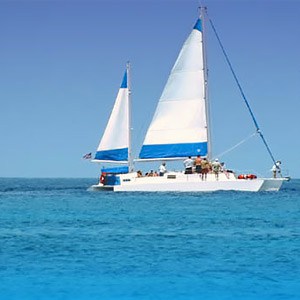Please Register / Login to take part in discussions about the Virgin Islands.
hi,
i was wondering how far is jost from red hook by boat. also jost to tortola? anyone know any great snorkling stops by boat in this area? thanks, scooby
I'd have to pull out my nautical maps to give you exat distances, but I ould say that it is about 10-15 nautical miles from STT to Yost and Soper's Hole, Tortola. You can get a ferry to them. Start looking around on the web, there are little hand books that list great snorkling and diving spots on the B.V.I. and American V.I's.
We went snorkling at Norman's Island, near Tortola I think in Nov and it was great snorkling because you swim into small caves. You do need to get some books about the BVIs as they're worth it and they're so close to STJ. If you rent your own boat, be sure to get a true navigational map to find the islands. The dumb useless "maps" my husband calls placemats are worthless. There are many, many islands and it would be easy to get lost unless you are already familiar with the islands.
hey guys,
what are nautical miles anyway. we rented a crewed cat. for the day. was wondering how far it is to jost from red hook, and tortola from jost is. don't know my nautical miles sorry. english please lol it will be just us and we get to go where ever we want they said. within reason i'm sure.
also we are going to norman [the caves] with limnos on another day so was wondering if anyone can tell me another great spot for snorkling, not just the regular common places that the crowds go to. thanks all, scooby
Who says you can't learn anything on bulletin boards and chat pages
Way more information than one should know, but jeopardy is coming to your town. LOL
==========================================
Definition
The international standard definition is: 1 nautical mile = 1852 metres (exactly).
[edit]
Unit symbol
There is no official international standard symbol for the unit nautical mile. The symbols NM, nm and nmi are commonly used in some areas (not to be confused with nm, the official symbol for nanometer).
The International Bureau of Weights and Measures (BIPM) in its International System of Units brochure lists the nautical mile in the table of units "currently accepted" for use with SI without using a symbol, saying in a footnote: "As yet there is no internationally agreed symbol."
Although nm is the official symbol for nanometre, there is little confusion because it is used in very different contexts, and differs by twelve orders of magnitude (one nautical mile = 1852 billion nanometres). For example, listings of aircraft flight ranges will have nm next to km (kilometres).
There are several national unit symbols in use, for example mpk (meripeninkulma, "sea league") in Finnish and sm (Seemeile, "sea mile") in German.
[edit]
Conversions to other units
1 nautical mile of 1852 metres converts to:
1.150 779 45 statute miles
6,076.115 49 feet
[edit]
History
The nautical mile was historically defined as a minute of arc along a great circle of the Earth. It can therefore be used for approximate measures on a meridian as change of latitude on a nautical chart. However, like all planets, the Earth is not a perfect sphere. It bulges at the equator like a spinning top, so the length of one minute of arc on the Earth's surface varies from 1862 m at the poles to 1843 m at the Equator. The Earth's surface also has bumps and hollows like a potato. Thus, there is no fixed relationship between angle and arc length along the Earth's surface; one minute of arc can vary in length by tens of metres.
The British definition related to the length on the surface of the Earth just south of Great Britain. It was 6080 feet (1853.184 metres). The Royal Hydrographic Office of the United Kingdom converted to the international definition in 1970.
In the United States, the nautical mile was defined as 6080.2 ft (1853.249 m). It adopted the international definition in 1954.
The precise definition of feet varied around the world. That was resolved in 1959 when a single definition of the international yard was agreed upon.
Other nations had different definitions. International agreement was achieved in 1929, when the International Extraordinary Hydrographic Conference, Monaco adopted a definition of 1 international nautical mile = 1,852 metres, roughly the average length of one minute of latitude i.e. one minute of arc along a line of longitude (a meridian). In subsequent years, nations converted to use of the international definition.
[edit]
Associated units
The derived unit of speed is the knot, defined as one nautical mile per hour.
The term "knot" derived from the practice of using a knotted rope as a method of gauging speed of a ship. The rope would be thrown into the water and the rope trailed behind the ship. The number of knots that passed off the ship and into the water in a given time would determine the speed in "knots". The term stuck since "knot" is so close to "naut" in "nautical".
Again, for maritime navigation, nautical miles are sometimes divided into 10 cables, although other precise definitions of a cable have also been used.
lol thanks tom ! scooby
the crew on the "cat"that you have for the day should have a good idea of what to do and where to go. you dont want to travel all day by boat to go to one spot.the crew will have a routine that they do for all their charters.happy sailling.



